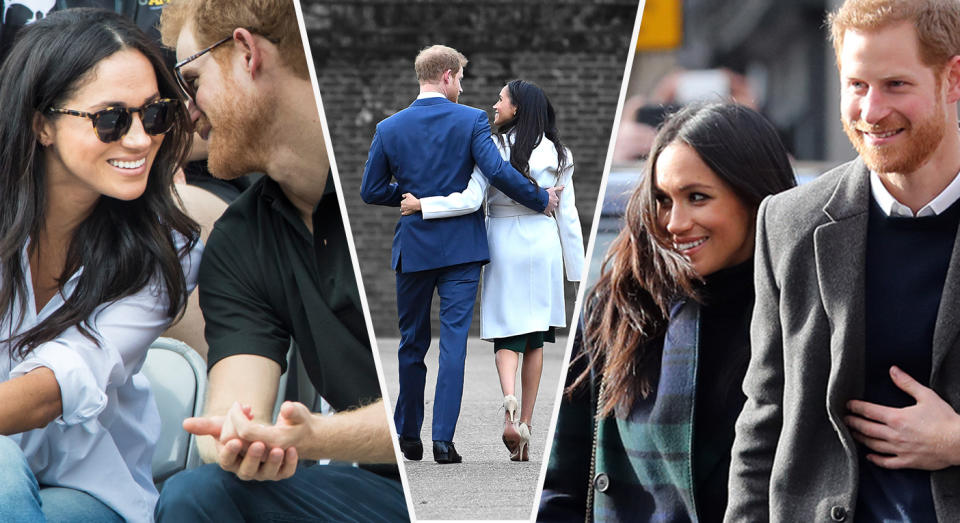Why do we have flower girls, page boys and bridesmaids at weddings?
![Where does the Page Boy, Bridesmaid and Flower Girl tradition come from? [Photo: PA]](https://s.yimg.com/ny/api/res/1.2/.A00jBu__A6A2sh21cZ2lQ--/YXBwaWQ9aGlnaGxhbmRlcjt3PTEyNDI7aD03NzQ-/https://media.zenfs.com/en/homerun/feed_manager_auto_publish_494/1564eb376db957a614313a90ca40ff44)
With just a few days to go until the royal wedding of the decade, Prince Harry and Meghan Markle have finally revealed who will be their bridesmaids and page boys.
As predicted, their royal cutenesses Prince George and Princess Charlotte will be playing key roles.
A statement released by Kensington Palace, revealed there will be a group of six bridesmaids and four page boys including George and Charlotte.
Prince Harry and Ms. Meghan Markle have chosen the Bridesmaids and Page Boys for their Wedding on Saturday 19th May #RoyalWedding: https://t.co/fRX7IA5Cn9
— Kensington Palace (@KensingtonRoyal) May 16, 2018
The mini-bridal party range in age from two to seven, and include a mixture of Harry’s and Meghan’s nieces and nephews, godchildren, and children of family friends. Aww!
![Prince George and Princess Charlotte on page boy and flower girl duty at Pippa Middleton’s wedding [Photo: PA]](https://s.yimg.com/ny/api/res/1.2/ALG9Ltl5lXscjq4y63lLZQ--/YXBwaWQ9aGlnaGxhbmRlcjt3PTk2MDtoPTE0NDk-/https://media.zenfs.com/en/homerun/feed_manager_auto_publish_494/422dd06a2280b0e5f120c787c78e8c94)
It’s not the first time the Duke and Duchess of Cambridge’s eldest children have played a starring role in a high-profile wedding.
The sweet siblings first took on page boy and flower girl roles at their auntie Pippa Middleton’s wedding to James Matthews on 20th May 2017.
But where does the tradition to have bridesmaids, flower girls and page boys stem from?
Page Boys
“Page Boys are basically young male wedding attendants who traditionally helped carry the bride’s train as she walked down the aisle (In the past bride’s trains were always very long),” explains gift site borngifted.co.uk.
The word ‘Page’ actually comes from the medieval term for young male servant.
The site goes on to say that historically the Page Boys’ role started in Western Europe before spreading to other parts of the world.
Though Page Boys don’t actually have any ‘official’ wedding duties, traditionally they have helped carry the bride’s train, so we could well see Prince George helping to lift up Meghan’s dress on Saturday.
A slight variation on the Page Boy is the mini ‘Ring Bearer’ whose starring role it is to carry the rings and give them to the Groom at the altar. What could possibly go wrong?
Though it used to be that this role was given to younger members of the wedding party, nowadays it is more common for the best man to take charge of the ring presenting. Cue collective sighs of relief all round.
![Ever wondered why bridesmaids often wear the same? [Photo: Blake Newman via Pexels]](https://s.yimg.com/ny/api/res/1.2/fnbSiaH13X_OUYKjnKwO6w--/YXBwaWQ9aGlnaGxhbmRlcjt3PTk2MDtoPTYzOA--/https://media.zenfs.com/en/homerun/feed_manager_auto_publish_494/df789c00a32b05bd84beceaf9565fed2)
Bridesmaids
Nowadays they’re invaluable for providing support, helping the bride get into and out of their dress when she needs to pee, and of course throwing an amazing hen party, but bridesmaids used to have a more serious role in the wedding – protecting the bride from evil spirits and unwanted wedding crashers.
Ever wondered why bridesmaids often wear the same coloured frocks? Well it’s all connected.
According to Hanne Blank, author of Virgin, the Untouched History, the real reason behind this wasn’t to look super coordinated but to “confuse evil spirits or those who wished to harm the bride.”
In early Roman times, the law required 10 witnesses to be present at a wedding. Those bridesmaids, who were often the bride’s actual maids (hence the name), gathered around the bride to form a kind of protective troop on the walk to the groom’s village.
The group of similarly dressed bridesmaids was supposed to intervene if wannabe suitors tried to hurt the bride or steal her dowry. Dark huh?
![Flower girls scatter flowers to symbolise fertility [Photo: Getty]](https://s.yimg.com/ny/api/res/1.2/_Cc4W.KvBv_9rqgCgh7wKg--/YXBwaWQ9aGlnaGxhbmRlcjt3PTk2MDtoPTYzOQ--/https://media.zenfs.com/en/homerun/feed_manager_auto_publish_494/25e8e46724ae3cc297e342b819830e82)
Flower girls
While the main purpose of including flower girls in today’s wedding ceremonies is to allow the bride a whimsical opportunity to pick out their too-cute gowns and adorable accessories, the origins of the tradition actually date back centuries.
The petals scattered by mini flower girls don’t just look pretty, in times gone by they were actually seen as a symbol of fertility. In the past herbs were used as a way to ward off evil (generations before were sure worried about evil spirits at a wedding!).
But there’s another reason flower girls were included in the wedding party – to offer a representation of the transformation of the bride from childhood to present day.
While today’s weddings might not have as much of a symbolic take on the inclusion of flower girls, those traditional meanings still hold strong. And boy they sure up the Aww factor.
We can’t wait to see Princess Charlotte and Prince George in their traditional roles on Saturday.
Follow us on Instagram and Facebook for non-stop inspiration delivered fresh to your feed, every day. For Twitter updates, follow @YahooStyleUK.
Read more from Yahoo Style UK:
From afternoon tea to rooftop screenings: The best ways to celebrate the royal wedding
A deep dive into all the tiaras Meghan Markle might wear on her wedding day
Prince Harry and Meghan Markle’s royal wedding: The date, details and latest news



